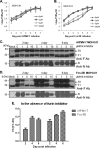Mutation of the f-protein cleavage site of avian paramyxovirus type 7 results in furin cleavage, fusion promotion, and increased replication in vitro but not increased replication, tissue tropism, or virulence in chickens
- PMID: 22258248
- PMCID: PMC3302521
- DOI: 10.1128/JVI.06765-11
Mutation of the f-protein cleavage site of avian paramyxovirus type 7 results in furin cleavage, fusion promotion, and increased replication in vitro but not increased replication, tissue tropism, or virulence in chickens
Abstract
We constructed a reverse genetics system for avian paramyxovirus serotype 7 (APMV-7) to investigate the role of the fusion F glycoprotein in tissue tropism and virulence. The AMPV-7 F protein has a single basic residue arginine (R) at position -1 in the F cleavage site sequence and also is unusual in having alanine at position +2 (LPSSR↓FA) (underlining indicates the basic amino acids at the F protein cleavage site, and the arrow indicates the site of cleavage.). APMV-7 does not form syncytia or plaques in cell culture, but its replication in vitro does not depend on, and is not increased by, added protease. Two mutants were successfully recovered in which the cleavage site was modified to mimic sites that are found in virulent Newcastle disease virus isolates and to contain 4 or 5 basic residues as well as isoleucine in the +2 position: (RRQKR↓FI) or (RRKKR↓FI), named Fcs-4B or Fcs-5B, respectively. In cell culture, one of the mutants, Fcs-5B, formed protease-independent syncytia and grew to 10-fold-higher titers compared to the parent and Fcs-4B viruses. This indicated the importance of the single additional basic residue (K) at position -3. Syncytium formation and virus yield of the Fcs-5B virus was impaired by the furin inhibitor decanoyl-RVKR-CMK, whereas parental APMV-7 was not affected. APMV-7 is avirulent in chickens and is limited in tropism to the upper respiratory tract of 1-day-old and 2-week-old chickens, and these characteristics were unchanged for the two mutant viruses. Thus, the acquisition of furin cleavability by APMV-7 resulted in syncytium formation and increased virus yield in vitro but did not alter virus yield, tropism, or virulence in chickens.
Figures






References
-
- Alexander D. 2003. Paramyxoviridae, 11th ed Iowa State University Press, Ames, IA
-
- Alexander D, Senne D. 2008. Newcastle disease and other avian paramyxovirus and pneumovirus infection, p 75–115 In Saif YM, Fadly AM, Glisson JR. (ed), Diseases of poultry. Iowa State University Press, Ames, IA
-
- Alexander DJ, Hinshaw VS, Collins MS. 1981. Characterization of viruses from doves representing a new serotype of avian paramyxoviruses. Arch. Virol. 68:265–269 - PubMed
-
- Collins MS, Bashiruddin JB, Alexander DJ. 1993. Deduced amino acid sequences at the fusion protein cleavage site of Newcastle disease viruses showing variation in antigenicity and pathogenicity. Arch. Virol. 128:363–370 - PubMed
-
- Collins PL, et al. 1995. Production of infectious human respiratory syncytial virus from cloned cDNA confirms an essential role for the transcription elongation factor from the 5′ proximal open reading frame of the M2 mRNA in gene expression and provides a capability for vaccine development. Proc. Natl. Acad. Sci. U. S. A. 92:11563–11567 - PMC - PubMed
Publication types
MeSH terms
Substances
Grants and funding
LinkOut - more resources
Full Text Sources
Research Materials
Miscellaneous

